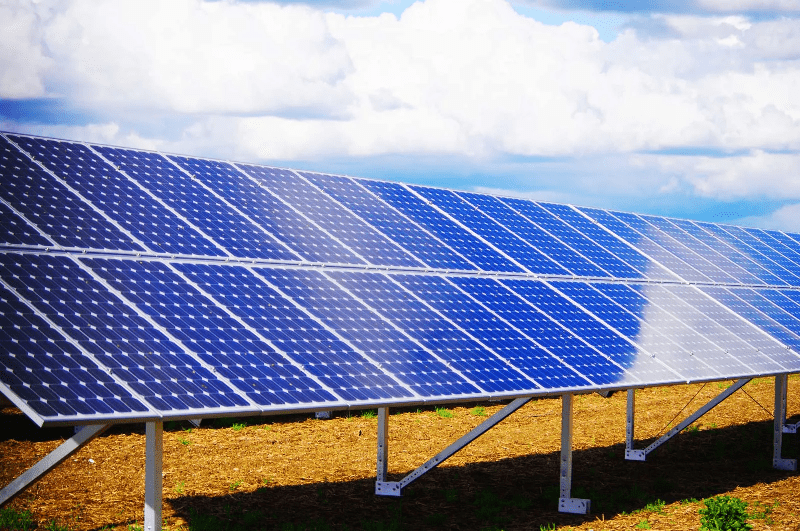In Short : Agrivoltaics, the practice of combining solar energy production with agricultural activities, could play a crucial role in achieving Colorado’s renewable energy goals. This innovative approach allows solar panels to coexist with crops, providing shade and optimizing land use. Energy and Environment Leadership panelists highlight the potential of agrivoltaics to enhance renewable energy capacity while supporting sustainable agriculture. By harnessing the sun’s energy above agricultural lands, Colorado can bolster its clean energy efforts, contribute to food production, and foster environmental conservation simultaneously.
In Detail : Coloradans in the ag and energy fields are exploring new technologies to reach 100% renewable energy by 2040.
These technologies were a point of discussion on the final day of the third annual Energy and Environment Leadership Symposium on Friday at the University of Northern Colorado in Greeley.
Friday’s small group discussions and five-person panel focused on the opportunities and challenges of agrivoltaics, a new technology that allows farmland to be used simultaneously for agriculture and solar photovoltaic energy generation.
Before the panel, Gov. Jared Polis shared his remarks on Colorado’s “exciting” future with lower costs and more sustainability. By 2029, Polis said, the state will reach 80% renewable energy on its path to reach 100% renewable energy by 2040.
The clean energy industry has invested more than $12 billion in Colorado, employed 15,00 people and contributed huge amounts to the economy, according to Polis. To find better solutions for sustainability, there is still work to do, Polis said, and it requires working together.
“Colorado is most successful when our ideas and our solutions come from thoughtful discussion and dialogue, and when everyone is at the table,” Polis said.
Colorado is exploring new technologies, like agrivoltaics, where farmers can stack multiple revenue streams on the same acreage without disrupting operations, Polis continued.
Agrivoltaics allow for innovation, according to Gene Kelly, deputy director of the Colorado Agricultural Experiment Station. The economic benefit comes from the dual-purpose land — producing food and energy simultaneously. The system also helps conserve water and doesn’t take the land out of production because livestock can graze underneath the solar arrays.
A roundtable participant described agrivoltaics in one word: necessary — because it’s society’s job to find solutions for the climate crisis humans have created, the participant said. Another participant thought of the word “optimism” in regard to the new solution moving forward in the future.
Agrivoltaics uses microclimates created by solar panels for shade to benefit ag businesses and activities, according to Byon Kominek, founder of Jack’s Solar Garden. He thinks of “stewardship” of the space within a solar array that keeps the land useful, the soil healthy and allows for better water infiltration.
Kominek, who spoke on the panel, owns a 5-acre community solar garden south of Longmont. He partners with the University of Arizona, Colorado State University, the National Renewable Energy Laboratory and Sprout City Farms to create research plots.
Kominek used solar to make more money after his family-owned farm struggled with hay production. Agrivoltaics have helped keep access to his family’s land and kept the land useful. Kominek has seen, and tasted, the benefits of agrivoltaics.
His 6- to 7-foot solar panels reflect heat radiated from the ground at night, which protects crops if a soft freeze comes through. He has even experienced a season extension of three to four weeks with the raspberries under his panels. The shade also reduces evaporation and keeps moisture in the ground longer.
Yet, there are concerns about the big investment in agrivoltaics, especially the expense of raising steel for animals grazing underneath. But Kelly, another panelist, said there are other ideas out there. For example, he said, places in Europe are using cables instead of steel for the system.
“I think the potential for this is enormous in Colorado,” Kelly said. “This is a real opportunity to drive us closer more quickly than we do in any other way.”
The agrivoltaics panel, moderated by Colorado Rep. Matt Soper, also included a presentation about a new agrivoltaics project approved in Weld County. Zach Brammer, panelist and founder of Cloudbreak Energy, created a solar project that allows for a local wheat and alfalfa farm to remain fully operational with agrivoltaics.
Typical agrivoltaics systems are often used for sheep grazing or native pasture land, he said. However, Brammer’s project is different — spacing panels 33 feet apart, instead of the standard 20 feet, to allow for trucks to turn around. The project will also add an underground drip irrigation system.
Brammer said his project is the first of its kind in the nation. He hopes to replicate efforts in Weld and across the nation.
Other panel guests included Ali Kairys, vice president of project development at Silicon Ranch, and Andrew Holder, area manager for community relations and local government affairs for Xcel Energy.
Holder also led a presentation on “Building Colorado’s Energy Future” to kick off the symposium Friday.
“We are at this point in time where we are the first generation to really experience climate change … and we’re the last to do something about it,” Kelly said. “We look at ag as evolving over time. But we don’t need evolution. We need a revolution.”

